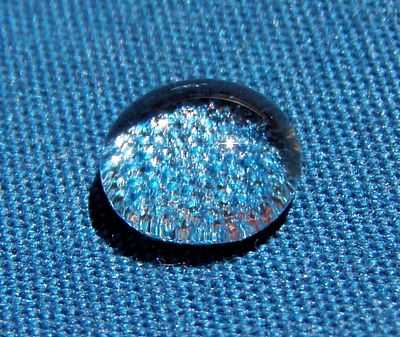Fluorosurfactant


Fluorosurfactants, or fluorinated surfactants, are synthetic organofluorine chemical compounds that have multiple fluorine atoms. They can be polyfluorinated or fluorocarbon-based (perfluorinated).[1] As surfactants, they are more effective at lowering the surface tension of water than comparable hydrocarbon surfactants. They have a fluorinated "tail" and a hydrophilic "head." Some fluorosurfactants, such as PFOS, are detected in humans and wildlife.[2]
Physical and chemical properties
Fluorosurfactants can lower the surface tension of water down to a value half of what is attainable by using hydrocarbon surfactants.[3] This ability is due to the lipophobic nature of fluorocarbons, as fluorosurfactants tend to concentrate at the liquid-air interface.[4] They are not as susceptible to the London dispersion force, a factor contributing to lipophilicity, because the electronegativity of fluorine reduces the polarizability of the surfactants' fluorinated molecular surface. Therefore, the attractive interactions resulting from the "fleeting dipoles" are reduced, in comparison to hydrocarbon surfactants. Fluorosurfactants are more stable and fit for harsh conditions than hydrocarbon surfactants because of the stability of the carbon–fluorine bond. Likewise, perfluorinated surfactants persist in the environment for that reason.[2]

Economic role
Fluorosurfactants play a key economic role for companies such as DuPont, 3M, and W. L. Gore & Associates because they are used in emulsion polymerization to produce fluoropolymers. Fluorosurfactants have two main markets: a $1 billion annual market for use in stain repellents, and a $100 million annual market for use in polishes, paints, and coatings.[5]
Health and environmental concerns
Some fluorosurfactants have caught the attention of regulatory agencies because of their persistence, toxicity, and widespread occurrence in the blood of general populations[6] and wildlife, such as perfluorooctanesulfonic acid (PFOS), perfluorooctanoic acid (PFOA), and perfluorononanoic acid (PFNA). As studies give evidence that longer fluorosurfactants are more bioaccumulative and toxic, some companies are marketing shorter fluorosurfactants.[5] For example, 3M is marketing two fluorosurfactants based upon the four carbon perfluorobutanesulfonic acid.[5] There are also concerns about the potential impacts of fluorinated alternatives including short-chain poly- and perfluorinated alkyl substances on human health and the environment.[7]
References
- ↑ Lehmler, HJ (2005). "Synthesis of environmentally relevant fluorinated surfactants—a review". Chemosphere 58 (11): 1471–96. doi:10.1016/j.chemosphere.2004.11.078. PMID 15694468.
- ↑ 2.0 2.1 Houde M, Martin JW, Letcher RJ, Solomon KR, Muir DC (June 2006). "Biological monitoring of polyfluoroalkyl substances: A review". Environ. Sci. Technol. 40 (11): 3463–73. doi:10.1021/es052580b. PMID 16786681. Supporting Information (PDF).
- ↑ Salager, Jean-Louis (2002). "Surfactants-Types and Uses" (PDF). FIRP Booklet # 300-A. Universidad de los Andes Laboratory of Formulation, Interfaces Rheology, and Processes. p. 45. Retrieved 7 September 2008.
- ↑ "Fluorosurfactant — Structure / Function". Mason Chemical Company. Retrieved 1 November 2008.
- ↑ 5.0 5.1 5.2 Renner R (2006). "The long and the short of perfluorinated replacements". Environ. Sci. Technol. 40 (1): 12–3. doi:10.1021/es062612a. PMID 16433328.
- ↑ Calafat AM, Wong LY, Kuklenyik Z, Reidy JA, Needham LL (2007). "Polyfluoroalkyl chemicals in the U.S. population: data from the National Health and Nutrition Examination Survey (NHANES) 2003-2004 and comparisons with NHANES 1999-2000". Environ Health Perspect. 115 (11): 1596–602. doi:10.1289/ehp.10598. PMC 2072821. PMID 18007991.
- ↑ Scheringer M, Trier X, Cousins IT, de Voogt P, Fletcher T, Wang Z, Webster TF (2014). "Helsingør Statement on poly- and perfluorinated alkyl substances (PFASs)". Chemosphere. doi:10.1016/j.chemosphere.2014.05.044.